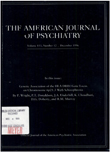Effects of haloperidol challenge on regional cerebral glucose utilization in normal human subjects
Abstract
OBJECTIVE: Positron emission tomography and the fluorodeoxyglucose (FDG) method were used to determine the brain's metabolic response to neuroleptic challenge in a normal, disease-free state. METHOD: FDG measurements were obtained before and 12 hours after administration of 5 mg of haloperidol to 12 young normal men. These values were compared with test-retest FDG measures obtained from nine normal male control subjects who received no drug intervention. RESULTS: After haloperidol administration, the haloperidol subjects showed significantly lower glucose utilization in the neocortex, limbic cortex, thalamus, and caudate nucleus but not in the putamen or cerebellum. After adjustment for global effects, significant reductions were still evident in the frontal, occipital, and anterior cingulate cortex, whereas the putamen and cerebellum showed significant increases. CONCLUSIONS: This study, measuring the brain's metabolic response to acute receptor blockade, is a first step in the development of an assay of CNS pharmacological activity. By determining the response to neuroleptic challenge in a normal state, the study establishes a comparison group for determining response to challenge in various psychiatric conditions.
Access content
To read the fulltext, please use one of the options below to sign in or purchase access.- Personal login
- Institutional Login
- Sign in via OpenAthens
- Register for access
-
Please login/register if you wish to pair your device and check access availability.
Not a subscriber?
PsychiatryOnline subscription options offer access to the DSM-5 library, books, journals, CME, and patient resources. This all-in-one virtual library provides psychiatrists and mental health professionals with key resources for diagnosis, treatment, research, and professional development.
Need more help? PsychiatryOnline Customer Service may be reached by emailing [email protected] or by calling 800-368-5777 (in the U.S.) or 703-907-7322 (outside the U.S.).



